Sensitivity of WRF Operational Forecasting to AIFS Initialisation: A Case Study on the Implications for Air Pollutant Dispersion
Abstract
1. Introduction
2. Materials and Methods
2.1. Area Characteristics
2.2. Modelling Approach
2.2.1. WRF Modelling System
| Scheme/Parameterisation/Option | Option Selected |
|---|---|
| Modelling Domains | d01, d02, d03 |
| Horizontal resolution | 9 km (d01), 3 km (d02), 1 km (d03) |
| Vertical levels | 42, 25 below 1500 m a.g.l |
| Lowest level | 8 m a.g.l |
| Topography | GTOPO30 |
| Land Uses | USGS |
| Microphysics | SBU-Lin [47] |
| Longwave Radiation | RRTMG [48] |
| Shortwave Radiation | Dudhia [49] |
| Cumulus | Kain-Fritsch [50] |
| Surface Layer | MM5 similarity [51] |
| Land Surface | Noah LSM [52] |
| Planetary Boundary Layer | Yonsei University [53] |
2.2.2. Global Model Initialisations
2.2.3. Transport and Dispersion Modelling
2.2.4. Ventilation Index
2.3. Datasets, Modelling Analysis Period and Model Evaluation
2.3.1. Meteorological and Air Quality Station Data
2.3.2. Modelling Analysis Period
2.3.3. Radiosonde Data
2.3.4. Forecast Evaluation and Forecast Sensitivity Analysis
- A visual inspection of spatial differences. Bidimensional maps were generated to compare the geographical distribution of variables across WRF simulations initialised with different global models.
- A comparison of diurnal cycles. Observed and simulated diurnal cycles were compared at meteorological stations within the modelling domain.
- A comparison of wind roses. Observed wind roses were contrasted with those simulated by WRF, focusing on the station located in the city of Huelva.
- A comparison of the vertical profiles. Simulated vertical profiles of key variables were compared against radiosonde measurements to assess consistency across different initialisations.
- Impact on backward trajectories. Backward trajectories were analysed for real pollutant episodes to determine whether different initialisations led to divergent potential emission sources.
- Impact on dispersion modelling. Simulations using SO2 as a tracer from a hypothetical point source were used to evaluate how meteorological inputs influence dispersion patterns, particularly in scenarios involving industrial emissions.
- A comparison of the ventilation index (VI). VI values were calculated using different global model initialisations to assess their influence on atmospheric dispersion potential.
3. Results
3.1. Numerical Evaluation
3.2. Diurnal Cycles
3.3. Wind Rose Analysis
3.4. Visual Inspection of Differences
3.5. Comparison of Vertical Profiles
3.6. Effects over Backward Trajectories
3.7. Effects on Dispersion Modelling
3.8. Comparison of Ventilation Index
4. Discussion
5. Conclusions
- The choice of the global initialisation model has a minimal impact on overall forecast accuracy for wind speed and wind direction, and only slightly better results have been found for temperature and relative humidity when IFS is used as global initialisation model.
- Compared to the findings of [42], WRF parameterisations and the use of high-resolution physiographic datasets, such as topography and land use, play a more significant role in the performance of meteorological simulations.
- Noticeable differences were observed in wind pattern representation and the estimation of the PBLH. These differences, which originate from the global initialisation model, can lead to divergent conclusions regarding pollutant dispersion, the contribution of various emission sources to concentration levels, and decision-making in air quality management.
- The findings of this research may also support the development of probabilistic air quality forecasting systems based on ensemble approaches.
- To couple a photochemical model in long-term simulations to assess the impact of different global models used to initialise WRF on air quality forecasts using real local emissions.
- To evaluate the influence of global model initialisation on other key meteorological variables, such as precipitation.
- Additionally, future studies could benefit from estimating PBLH using the methodology proposed by [63] and comparing those values with WRF outputs.
Author Contributions
Funding
Data Availability Statement
Acknowledgments
Conflicts of Interest
Abbreviations
| AEMET | National Spanish Meteorological Agency |
| AI | Artificial Intelligence |
| AIFS | Artificial Intelligence/Integrated Forecasting System |
| ARW | Advanced Research WRF |
| CCAF | Anomaly Correlation |
| ECMWF | European Centre for Medium-Range Weather Forecasts |
| ERA5 | ECMWF Reanalysis v5 |
| GFS | Global Forecasting System |
| HYSPLIT | Hybrid Single-Particle Lagrangian Integrated Trajectory |
| LAMs | Limited-Area Models |
| LBCs | Lateral Boundary Conditions |
| m.a.g.l | Metres above ground level |
| m.a.s.l | Metres above sea level |
| MAGE | Mean Absolute Gross Error |
| MB | Mean Bias |
| NCAR | National Center of Atmospheric Research |
| RMSE | Root Mean Square Error |
| SDAF | Standard Deviation of Forecast Anomaly |
| SEEPS | Stable Equitable Error in Probability Space |
| USGS | United States Geological Survey |
| UTC | Universal Time Coordinated |
| VI | Ventilation Index |
| WRF | Weather Research and Forecasting System |
References
- EEA. How Air Pollution Affects Our Health; European Environment Agency: Copenhagen, Denmark, 2024; Available online: https://www.eea.europa.eu/en/topics/in-depth/air-pollution/eow-it-affects-our-health (accessed on 28 September 2025).
- Directive (EU) 2024/2881 of the European Parliament and of the Council of 23 October 2024 on Ambient Air Quality and Cleaner Air for Europe. Available online: https://eur-lex.europa.eu/eli/dir/2024/2881/oj (accessed on 28 September 2025).
- Tritscher, T.; Raz, R.; Levi, Y.; Levy, I.; Broday, D.M. Emissions vs. turbulence and atmospheric stability: A study of their relative importance in determining air pollutant concentrations. Sci. Total Environ. 2020, 733, 139300. [Google Scholar]
- Finnish Meteorological Institute. Model Serves its Purposes. Available online: https://en.ilmatieteenlaitos.fi/model-serves-its-purpose (accessed on 28 September 2025).
- NOAA. The Global Forecasting System (GFS); NOAA National Centers for Environmental Information: Asheville, NC, USA, 2025. Available online: https://www.emc.ncep.noaa.gov/emc/pages/numerical_forecast_systems/gfs/documentation.php (accessed on 24 March 2025).
- ECMWF. IFS Documentation; European Centre for Medium-Range Weather Forecasts: Shinfield Park, UK, 2024; Available online: https://www.ecmwf.int/en/publications/ifs-documentation (accessed on 24 March 2025).
- Skamarock, W.C.; Klemp, J.B.; Dudhia, J.; Gill, D.O.; Liu, Z.; Berner, J.; Wang, W.; Powers, J.G.; Duda, M.G.; Barker, D.M.; et al. A Description of the Advanced Research WRF Version 4. In NCAR Technical Note NCAR/TN-556+STR; National Center for Atmospheric Research: Boulder, CO, USA, 2019; p. 145. [Google Scholar] [CrossRef]
- Bengtsson, L.; Andrae, U.; Aspelien, T.; Batrak, Y.; Calvo, J.; de Rooy, W.; Gleeson, E.; Hansen-Sass, B.; Homleid, M.; Hortal, M.; et al. The HARMONIE–AROME Model Configuration in the ALADIN-HIRLAM NWP System. Mon. Weather. Rev. 2017, 145, 1919–1935. [Google Scholar] [CrossRef]
- Wu, Y.; Xue, W. Data-Driven Weather Forecasting and Climate Modeling from the Perspective of Development. Atmosphere 2024, 15, 689. [Google Scholar] [CrossRef]
- Zhang, H.; Liu, Y.; Zhang, C.; Li, N. Machine Learning Methods for Weather Forecasting: A Survey. Atmosphere 2025, 16, 82. [Google Scholar] [CrossRef]
- Chadalavada, S.; Faust, O.; Salvi, M.; Seoni, S.; Raj, N.; Raghavendra, U.; Gudigar, A.; Datta, P.; Barua, P.D.; Molinari, F.; et al. Application of artificial intelligence in air pollution monitoring and forecasting: A systematic review. Environ. Model. Softw. 2024, 185, 106312. [Google Scholar] [CrossRef]
- Li, Y.; Guo, J.; Sun, S.; Li, J.; Wang, S.; Zhang, S. Air quality forecasting with artificial intelligence techniques: A scientometric and content analysis. Environ. Model. Softw. 2022, 149, 105329. [Google Scholar] [CrossRef]
- ECMWF. AIFS: A New ECMWF Forecasting System; European Centre for Medium-Range Weather Forecasts: Reading, UK, 2025; Available online: https://www.ecmwf.int/en/newsletter/178/news/aifs-new-ecmwf-forecasting-system (accessed on 24 March 2025).
- Moldovan, G.; Pinnington, E.; Nemesio, A.P.; Lang, S.; Bouallègue, Z.B.; Dramsch, J.; Alexe, M.; Cruz, M.S.; Hahner, S.; Cook, H.; et al. An update to ECMWF’s machine-learned weather forecast model AIFS. arXiv 2025, arXiv:2509.18994v1. [Google Scholar] [CrossRef]
- Climate Data Store. ERA5 Hourly Data on Single Levels from 1940 to Present. Available online: https://cds.climate.copernicus.eu/datasets/reanalysis-era5-single-levels?tab=overview (accessed on 16 October 2025).
- ECMWF. Implementation of AIFS Single V1; European Centre for Medium-Range Weather Forecasts: Shinfield Park, UK, 2025; Available online: https://confluence.ecmwf.int/display/FCST/Implementation+of+AIFS+Single+v1 (accessed on 26 March 2025).
- ECMWF. AIFS-Single Vs. IFS Scorecard; European Centre for Medium-Range Weather Forecasts: Shinfield Park, UK, 2025; Available online: https://sites.ecmwf.int/aifs/scorecards/AIFS-single%20vs%20IFS%20scorecard.html (accessed on 26 March 2025).
- Zhang, Z.; Fischer, E.; Zscheischler, J.; Engelke, S. Numerical models outperform AI weather forecasts of record-breaking extremes. arXiv 2025, arXiv:2508.15724. [Google Scholar] [CrossRef]
- Figurski, M.J.; Nykie, L.G.; Jaczewski, A.; Baldysz, Z.; Wdowikowski, M. The impact of initial and boundary conditions on severe weather event simulations using a high-resolution WRF model. Case study of the derecho event in Poland on 11 August 2017. Meteorol. Hydrol. Water Manag. 2022, 10, 60–87. [Google Scholar] [CrossRef]
- Lang, S.; Alexe, M.; Chantry, M.; Dramsch, J.; Pinault, F.; Raoult, B.; Clare, M.C.A.; Lessig, C.; Maier-Gerber, M.; Magnusson, L.; et al. AIFS—ECMWF’s Data Driven Forecasting System. arXiv 2024, arXiv:2406.01465. [Google Scholar] [CrossRef]
- Nipen, T.N.; Haugen, H.H.; Ingstad, M.S.; Nordhagen, E.M.; Salihi, A.F.S.; Tedesco, P.; Seierstad, I.A.; Kristiansen, J.; Lang, S.; Alexe, M.; et al. Regional data-driven weather modeling with a global stretched grid. arXiv 2024, arXiv:2409.02891. [Google Scholar] [CrossRef]
- Cesari, R.; Paradisi, P.; Allegrini, P. Source identification by a statistical analysis of backward trajectories based on peak pollution events. Int. J. Environ. Pollut. 2014, 55, 94. [Google Scholar] [CrossRef]
- Querol, X.; Alastuey, A.; De la Rosa, J.; Sánchez-de-la-Campa, A.M.; Plana, F.; Ruiz, C.R. Source apportionment analysis of atmospheric particulates in an industrialised urban site in southwestern Spain. Atmos. Environ. 2002, 36, 3113–3125. [Google Scholar] [CrossRef]
- Cachorro, V.E.; Toledano, C.; Prats, N.; Sorribas, M.; Mogo, S.; Berjón, A.; Torres, B.; Rodrigo, R.; de la Rosa, J.; De Frutos, A.M. The strongest desert Dust intrusion mixed with smoke over the Iberian Peninsula registered with Sun photometry. J. Geophys. Res. Atmos. 2008, 113, D14. [Google Scholar] [CrossRef]
- Sánchez de la Campa, A.M.; De la Rosa, J.; Querol, X.; Alastuey, A.; Mantilla, E. Geochemistry and origin of PM10 in the Huelva región, Southwestern Spain. Environ. Res. 2007, 103, 305–316. [Google Scholar] [CrossRef] [PubMed]
- Sánchez de la Campa, A.M.; Sánchez-Rodas, D.; Alsioufi, L.; Alastuey, A.; Querol, X.; de la Rosa, J.D. Air quality trends in an industrialised area of SW Spain. J. Clean. Prod. 2018, 186, 465–474. [Google Scholar] [CrossRef]
- Fernández-Camacho, R.; De la Rosa, J.; Sánchez de la Campa, A.M.; González-Castanedo, Y.; Alastuey, A.; Querol, X.; Rodríguez, S. Geochemical characterization of Cu-smelter emission plumes with impact in an urban area of SW Spain. Atmos. Res. 2010, 96, 590–601. [Google Scholar] [CrossRef]
- González-Castanedo, G.; Moreno, T.; Fernández-Camacho, R.; Sánchez de la Campa, A.M.; Alastuey, A.; Querol, X.; De la Rosa, J. Size distribution and chemical composition of particulate matter stack emissions in and around a copper smelter. Atmos. Environ. 2014, 98, 271–282. [Google Scholar] [CrossRef]
- Chen, B.; Stein, A.F.; Castell, N.; Gonzalez-Castanedo, Y.; de la Campa, A.S.; de la Rosa, J. Modeling and evaluation of urban pollution events of atmospheric heavy metals from a large Cu-smelter. Sci. Total Environ. 2016, 539, 17–25. [Google Scholar] [CrossRef]
- Li, J.; Chen, B.; de la Campa, A.M.; Alastuey, A.; Querol, X.; de la Rosa, J.D. 2005–2014 trends of PM10 source contributions in an industrialized area of southern Spain. Environ. Pollut. 2018, 236, 570–579. [Google Scholar] [CrossRef]
- Millán-Martínez, M.; Sánchez-Rodas, D.; Sánchez de la Campa, A.M.; Alastuey, A.; Querol, X.; De la Rosa, J.D. Source contribution and origin of PM and arsenic in a complex industrial region (Huelva, SW Spain). Environ. Pollut. 2021, 274, 116268. [Google Scholar] [CrossRef]
- López-Cayuela, M.Á.; Córdoba-Jabonero, C.; Bermejo-Pantaleón, D.; Sicard, M.; Salgueiro, V.; Molero, F.; Carvajal-Pérez, C.V.; Granados-Muñoz, M.J.; Comerón, A.; Couto, F.T.; et al. Vertical characterization of fine and coarse dust particles during an intense Saharan dust outbreak over the Iberian Peninsula in springtime 2021. Atmos. Chem. Phys. 2021, 23, 143–161. [Google Scholar] [CrossRef]
- Porras, I.; Solé, J.; Marcos, R.; Arasa, R. Meteorological and Climate Modelling Services Tailored to Viticulturists. Atmos. Clim. Sci. 2021, 11, 148–164. [Google Scholar] [CrossRef]
- Solé, J.; Arasa, R.; Picanyol, M.; González, M.; Domingo-Dalmau, A.; Masdeu, M.; Porras, I.; Codina, B. Assessment of Climate Change in Nicaragua: Analysis of Precipitation and Temperature by Dynamical Downscaling over a 30-Year Horizon. Atmos. Clim. Sci. 2016, 6, 445–474. [Google Scholar] [CrossRef]
- Modi, A.; Harikumar, R.; Nair, T.M.B. Development of an Advance Research WRF-Based Operational Forecast System for Forcing Ocean Models and Evaluation of Its Winds Using Buoys in the Indian Ocean. Weather. Forecast. 2024, 39, 1459–1468. [Google Scholar] [CrossRef]
- Yáñez-Morroni, G.; Gironás, J.; Caneo, M.; Delgado, R.; Garreaud, R. Using the Weather Research and Forecasting (WRF) Model for Precipitation Forecasting in an Andean Region with Complex Topography. Atmosphere 2018, 9, 304. [Google Scholar] [CrossRef]
- Huang, H.; Qian, Y.; Bisht, G.; Wang, J.; Chakraborty, T.; Hao, D.; Li, J.; Thurber, T.; Singh, B.; Yang, Z.; et al. WRF-ELM v1.0: A regional climate model to study land–atmosphere interactions over heterogeneous land use regions. Geosci. Model Dev. 2025, 18, 1427–1443. [Google Scholar] [CrossRef]
- García-Valdecasas, M.; Gámiz-Fortis, S.; Castro-Díez, Y.; Esteban-Parra, M.J. Evaluation of WRF capability to detect try and wet periods in Spain using drought indices. JRG Atmos. 2017, 122, 1569–1594. [Google Scholar] [CrossRef]
- Donaire-Montaño, D.; García-Valdecasas Ojeda, M.; Tacoronte, N.; Rosa-Cánovas, J.J.; Castro-Díez, Y.; Esteban-Parra, M.J.; Gámiz-Fortis, S.R. Finding optimal Noah-MP parameterizations for the characterization of surface heat fluxes in the Iberian Peninsula. Atmospheric Res. 2025, 323, 108143. [Google Scholar] [CrossRef]
- Oliva, A.S.; García-Valdecasas Ojeda, M.; Arasa Agudo, R. Evaluation of the Sensitivity of the Weather Research and Forecasting Model to Changes in Physical Parameterizations During a Torrential Precipitation Event of the El Niño Costero 2017 in Peru. Water 2025, 17, 209. [Google Scholar] [CrossRef]
- Solano-Farias, F.; García-Valdecasas, M.; Donaire-Montaño, D.; Rosa-Cánovas, J.J.; Castro-Díez, Y.; Esteban-Parra, M.J.; Gámiz-Fortis, S.R. Assessment of physical schemes for WRF model in convection-permitting mode over southern Iberian Peninsula. Atmos. Res. 2024, 299, 107175. [Google Scholar] [CrossRef]
- Arasa, R.; Porras, I.; Domingo-Dalmau, A.; Picanyol, M.; Codina, B.; González, M.; Piñón, J. Defining a Standard Methodology to Obtain Optimum WRF Configuration for Operational Forecast: Application over the Port of Huelva (Southern Spain). Atmospheric Clim. Sci. 2016, 6, 329–350. [Google Scholar] [CrossRef]
- Reboredo, B.; Arasa, R.; Codina, B. Evaluating Sensitivity to Different Options and Parameterizations of a Coupled Air Quality Modelling System over Bogotá, Colombia. Part I: WRF Model Configuration. Open J. Air Pollut. 2015, 4, 47–64. [Google Scholar] [CrossRef][Green Version]
- Arasa, R.; Soler, M.R.; Olid, M. Evaluating the Performance of a Regional-Scale Photochemical Modelling System: Part I. Ozone Predictions. ISRN Meteorol. 2012, 2012, 860234. [Google Scholar] [CrossRef][Green Version]
- Seaman, N.; Gaudet, B.; Zielonka, J.; Stauffer, D. Sensitivity of Vertical Structure in the Stable Boundary Layer to Variations of the WRF Model’s Mellor-Yamada-Janjic Turbulence Scheme. In Proceedings of the 10th WRF Users’ Workshop, Boulder, CO, USA, 23–26 June 2009. [Google Scholar][Green Version]
- De Meij, A.; Ojha, N.; Singh, N.; Singh, J.; Poelman, D.R.; Pozzer, A. The Impact of High-Resolution SRTM Topography and Corine Land Cover on Lightning Calculations in WRF. Atmosphere 2022, 13, 1050. [Google Scholar] [CrossRef]
- Lin, Y.; Colle, B.A. A New Bulk Microphysical Scheme That Includes Varying Degree of Riming and Particle Habits. Mon. Weather Rev. 2011, 139, 1036–1047. [Google Scholar] [CrossRef]
- Iacono, M.J.; Delamere, J.S.; Mlawer, E.J.; Shephard, M.W.; Clough, S.A.; Collins, W. Radiative Forcing by Long-Lived Greenhouse Gases: Calculations with the AER Radiative Transfer Model. J. Geophys. Res. Atmos. 2008, 113, D13103. [Google Scholar] [CrossRef]
- Dudhia, J. Numerical Study of Convection Observed during the Winter Monsoon Experiment Using a Mesoscale Two-Dimensional Model. J. Atmos. Sci. 1989, 46, 3077–3104. [Google Scholar] [CrossRef]
- Kain, J.S. The Kain-Fritsch Convective Parameterization: An Update. J. Appl. Meteorol. 2004, 43, 170–181. [Google Scholar] [CrossRef]
- Zhang, D.L.; Anthes, R.A. A high-resolution model of the planetary boundary layer—Sensitivity tests and comparisons with SESAME-79 data. J. Appl. Meteorol. 1982, 21, 1594–1609. [Google Scholar] [CrossRef]
- Chen, F.; Dudhia, J. Coupling an Advanced Land Surface–Hydrology Model with the Penn State–NCAR MM5 Modeling System. Part I: Model Implementation and Sensitivity. Mon. Wea. Rev. 2001, 129, 569–585. [Google Scholar] [CrossRef]
- Hong, S.-Y.; Noh, Y.; Dudhia, J. A New Vertical Diffusion Package with an Explicit Treatment of Entrainment Processes. Mon. Weather Rev. 2006, 134, 2318–2341. [Google Scholar] [CrossRef]
- Stein, A.F.; Draxler, R.R.; Rolph, G.D.; Stunder, B.J.B.; Cohen, M.D.; Ngan, F. NOAA’s HYSPLIT atmospheric transport and dispersion modeling system. Bull. Amer. Meteor. Soc. 2015, 96, 2059–2077. [Google Scholar] [CrossRef]
- Romero-Macías, E.; Pérez-Vizcaíno, P.; Sánchez de la Campa, A.; Sánchez- Rodas, D.A.; Alastuey, A.; Querol, X.; De la Rosa, J.D. Extreme historic SO2 levels in an industrial city (Huelva, SW Spain). Air quality implications. RICTA. In Proceedings of the Poster Presented on the 8th Iberian Meeting on Aerosol Science and Technology, A Coruña, Spain, 26–28 June 2024. [Google Scholar]
- Pérez-Vizcaíno, P.; Sánchez de la Campa, A.M.; Sánchez-Rodas, D.; De la Rosa, J.D. Application of a near real-time technique for the assessment of atmospheric arsenic and metals emissions from a copper smelter in an urban area of SW Europe. Environ. Pollut. 2025, 367, 125602. [Google Scholar] [CrossRef] [PubMed]
- Pronóstico de Ventilación. Ministerio del Medio Ambiente, Gobierno de Chile. Available online: https://airecqp.mma.gob.cl/pronostico-de-ventilacion/ (accessed on 13 August 2025).
- Clearing Index. National Weather Service. Available online: https://www.weather.gov/slc/clearingindex (accessed on 13 August 2025).
- Ferguson, S.A.; McKay, S.J.; Nagel, D.E.; Piepho, T.; Rorig, M.L.; Anderson, C.; Kellogg, L. Assessing Values of Air Quality and Visibility at Risk from Wildland Fires; US Department of Agriculture, Forest Service, Pacific Northwest Research Station: Portland, OR, USA, 2003; p. 59.
- Air Quality Network of the Andalusian Government. Available online: https://www.juntadeandalucia.es/medioambiente/portal/landing-page-%C3%ADndice/-/asset_publisher/zX2ouZa4r1Rf/content/localizaci-c3-b3n-de-la-red-autom-c3-a1tica-de-calidad-del-aire/20151 (accessed on 26 May 2025).
- AEMET. Borrascas Con Gran Impacto 2024–2025. Available online: https://www.aemet.es/es/conocermas/borrascas/2024-2025 (accessed on 14 August 2025).
- AEMET. Climatological Summaries. Andalusia. Available online: https://www.aemet.es/documentos/es/serviciosclimaticos/vigilancia_clima/resumenes_climat/ccaa/andalucia-ceuta-melilla/avance_climat_acm_abr_2025.pdf (accessed on 5 August 2025).
- Comas Muguruza, A.; Arasa Agudo, R.; Udina, M. Characterization of the Planetary Boundary Layer Height in Huelva (Spain) During an Episode of High NO2 Pollutant Concentrations. Earth 2025, 6, 26. [Google Scholar] [CrossRef]
- Abida, R.; Addad, Y.; Francis, D.; Temimi, M.; Nelli, N.; Fonseca, R.; Nesterov, O.; Bosc, E. Evaluation of the Performance of the WRF Model in a Hyper-Arid Environment: A Sensitivity Study. Atmosphere 2022, 13, 985. [Google Scholar] [CrossRef]
- Rzeszutek, M.; Kłosowska, A.; Oleniacz, R. Accuracy Assessment of WRF Model in the Context of Air Quality Modeling in Complex Terrain. Sustainability 2023, 15, 12576. [Google Scholar] [CrossRef]
- Emery, C.; Tai, E. Enhanced Meteorological Modeling and Performance Evaluation for Two Texas Ozone Episodes; Texas Natural Resources Conservation Commission: Novato, CA, USA, 2001.
- Tesche, T.W.; McNally, D.E.; Tremback, C. Operational Evaluation of the MM5 Meteorological Model over the Continental United States: Protocol for Annual and Episodic Evaluation; Alpine Geophysics, LLC.: Boulder, CO, USA, 2002; Available online: http://www.epa.gov/scram001/reports/tesche_2002_evaluation_protocol.pdf (accessed on 27 May 2025).
- Jiménez, P.A.; González-Rouco, J.F.; García-Bustamante, E.; Navarro, J.; Montávez, J.P.; Vilà-Guerau de Arellano, J.; Dudhia, J.; Roldán, A. Surface Wind Regionalization over Complex Terrain: Evaluation and Analysis of a High-Resolution WRF Numerical Simulation. J. Appl. Meteorol. Climatol. 2010, 49, 268–287. [Google Scholar] [CrossRef]
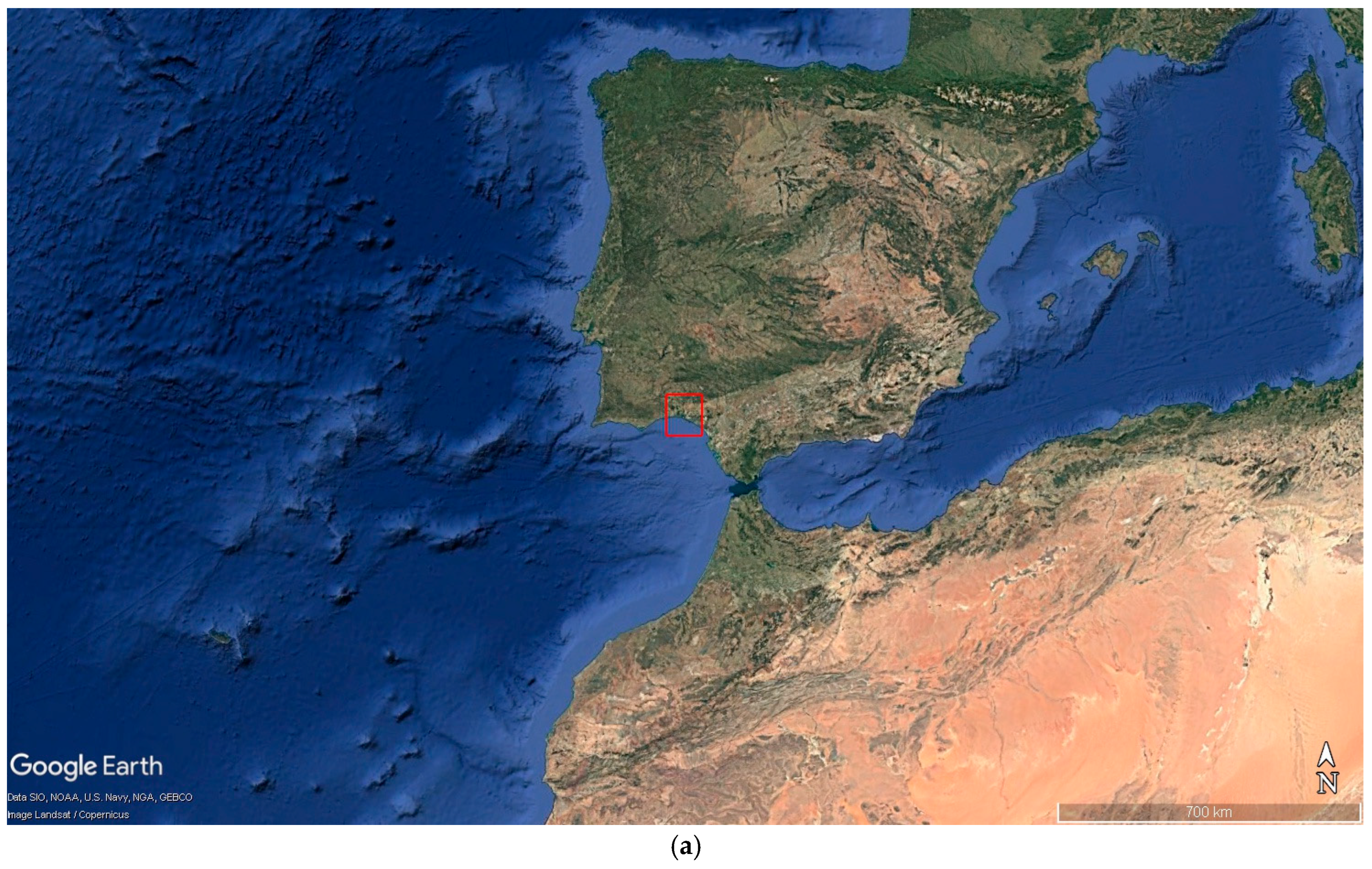
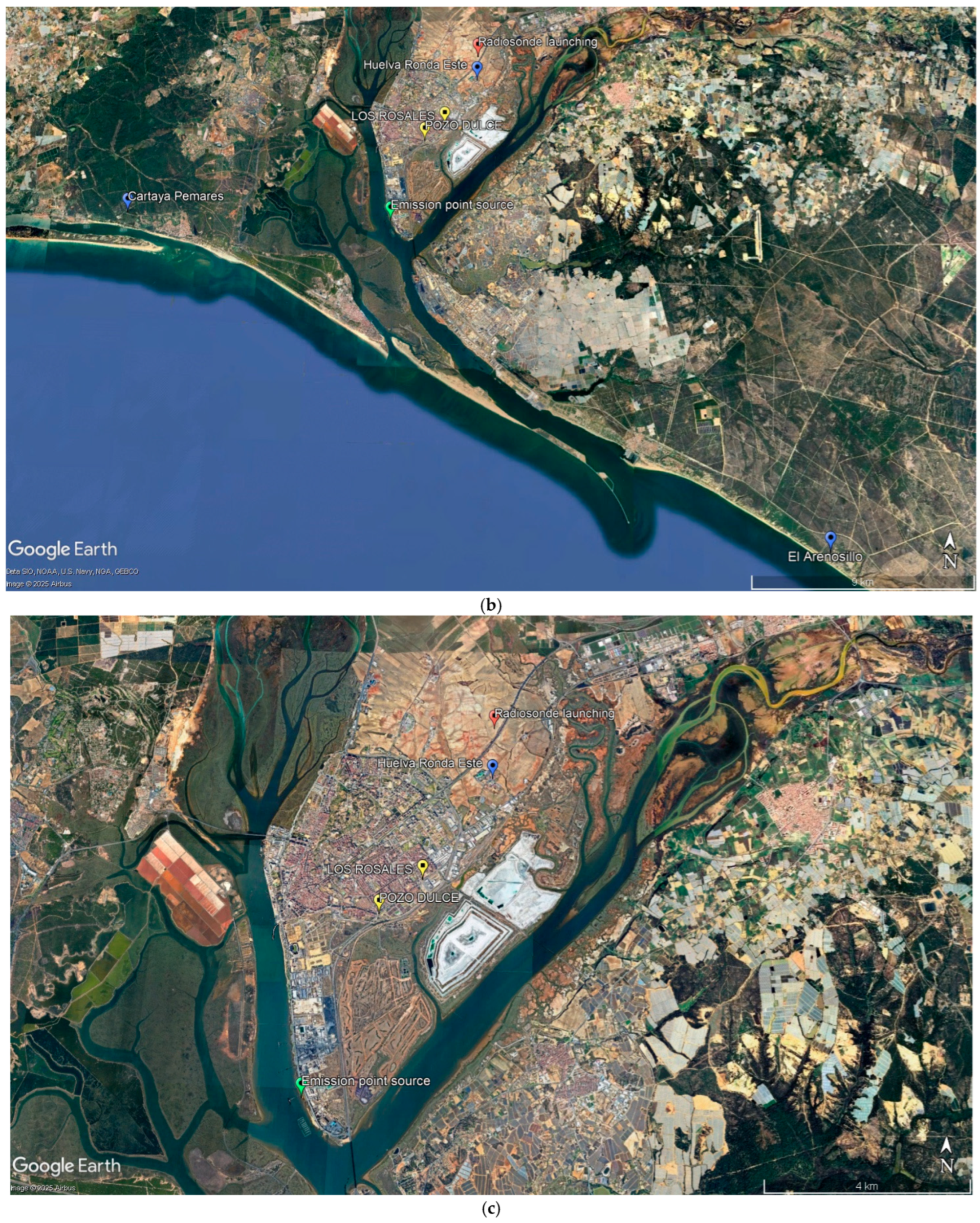
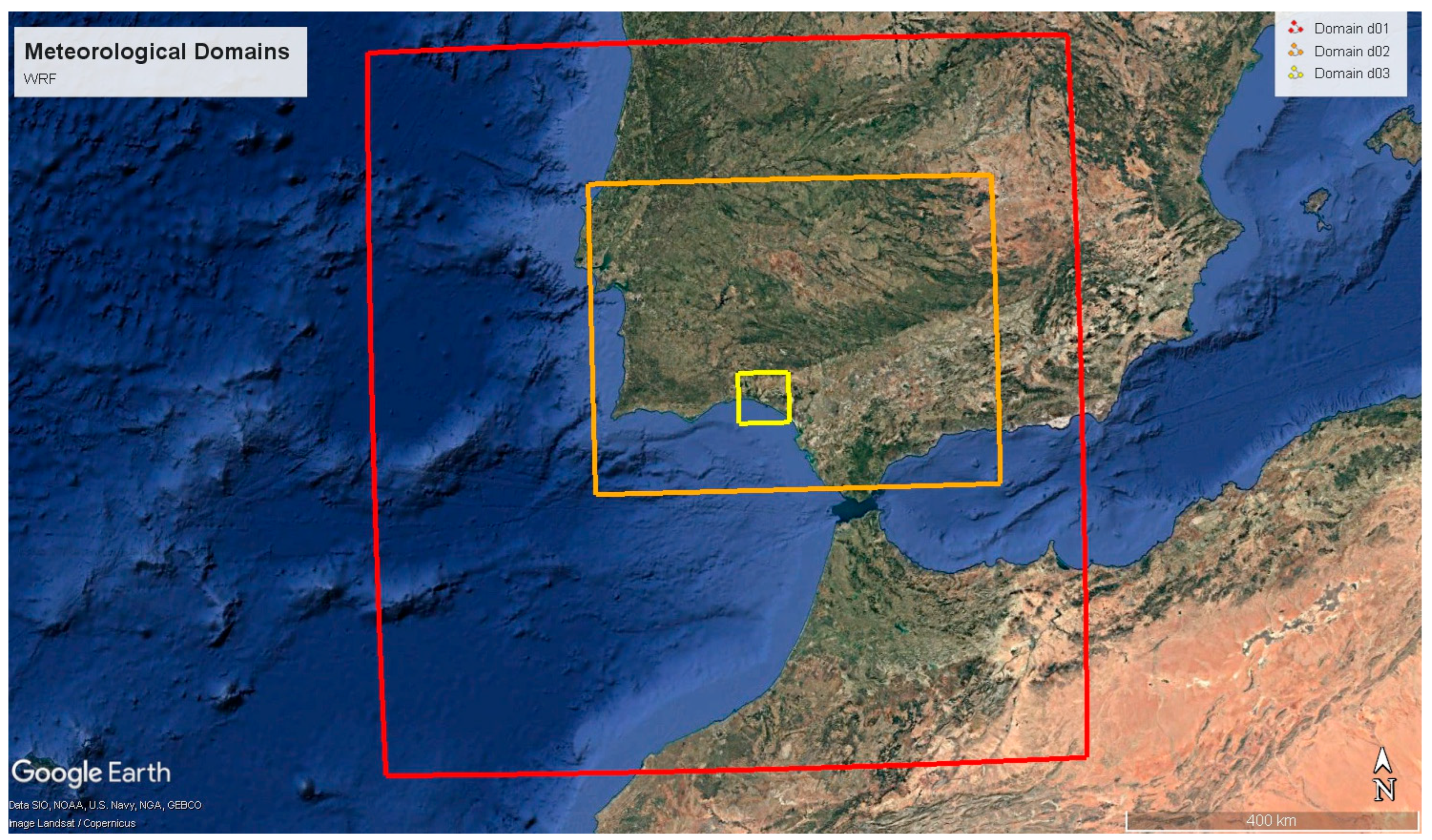



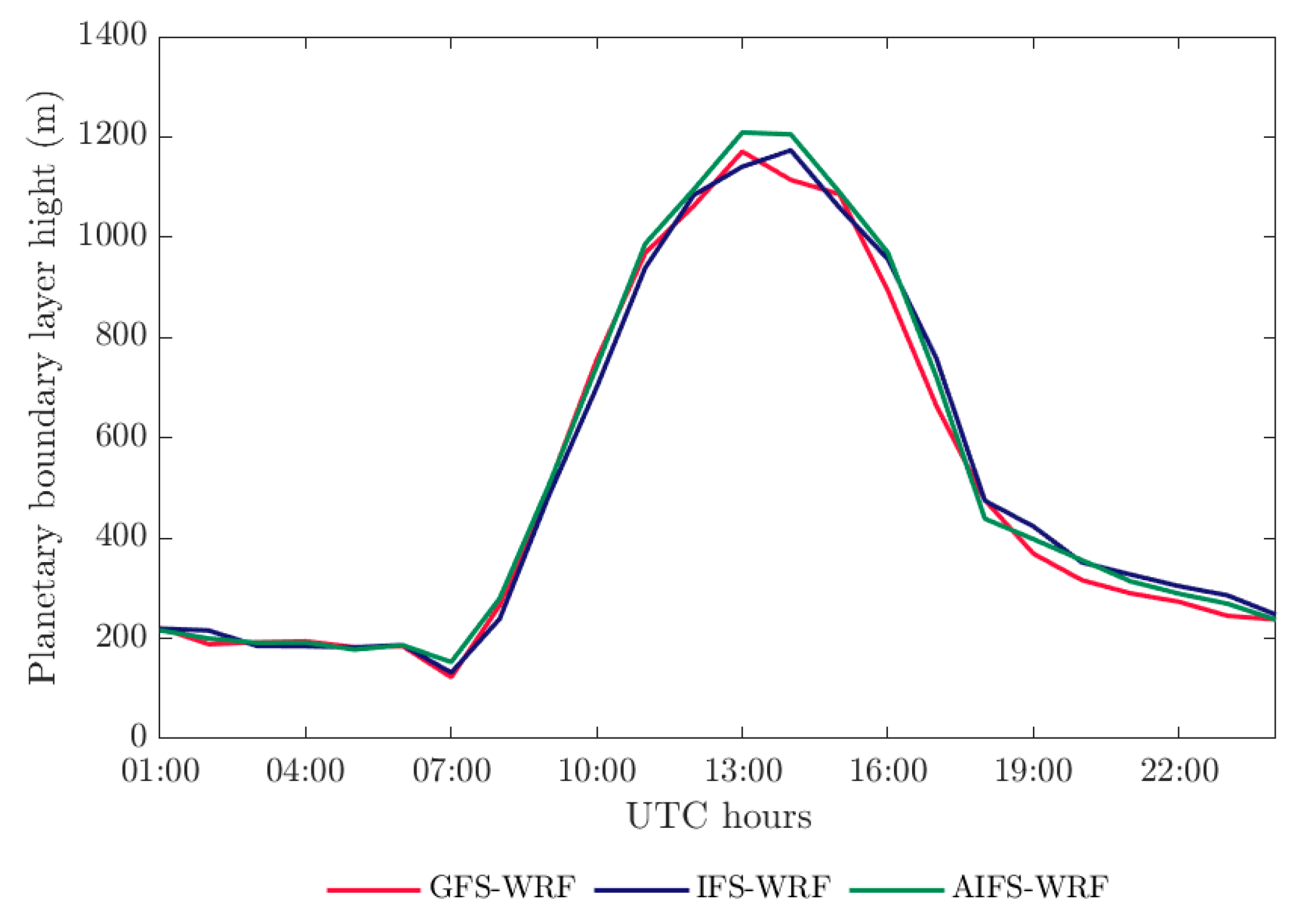
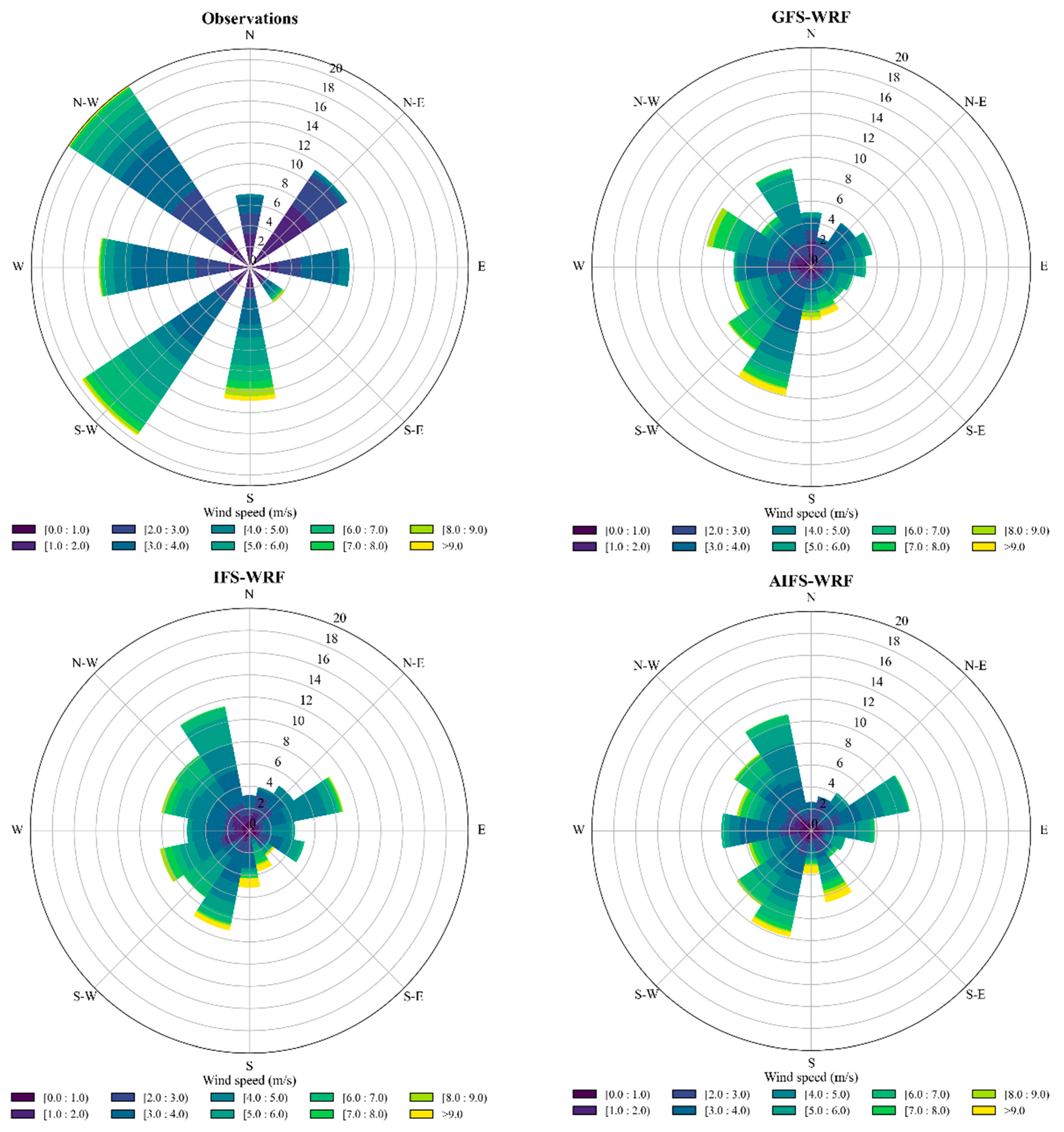
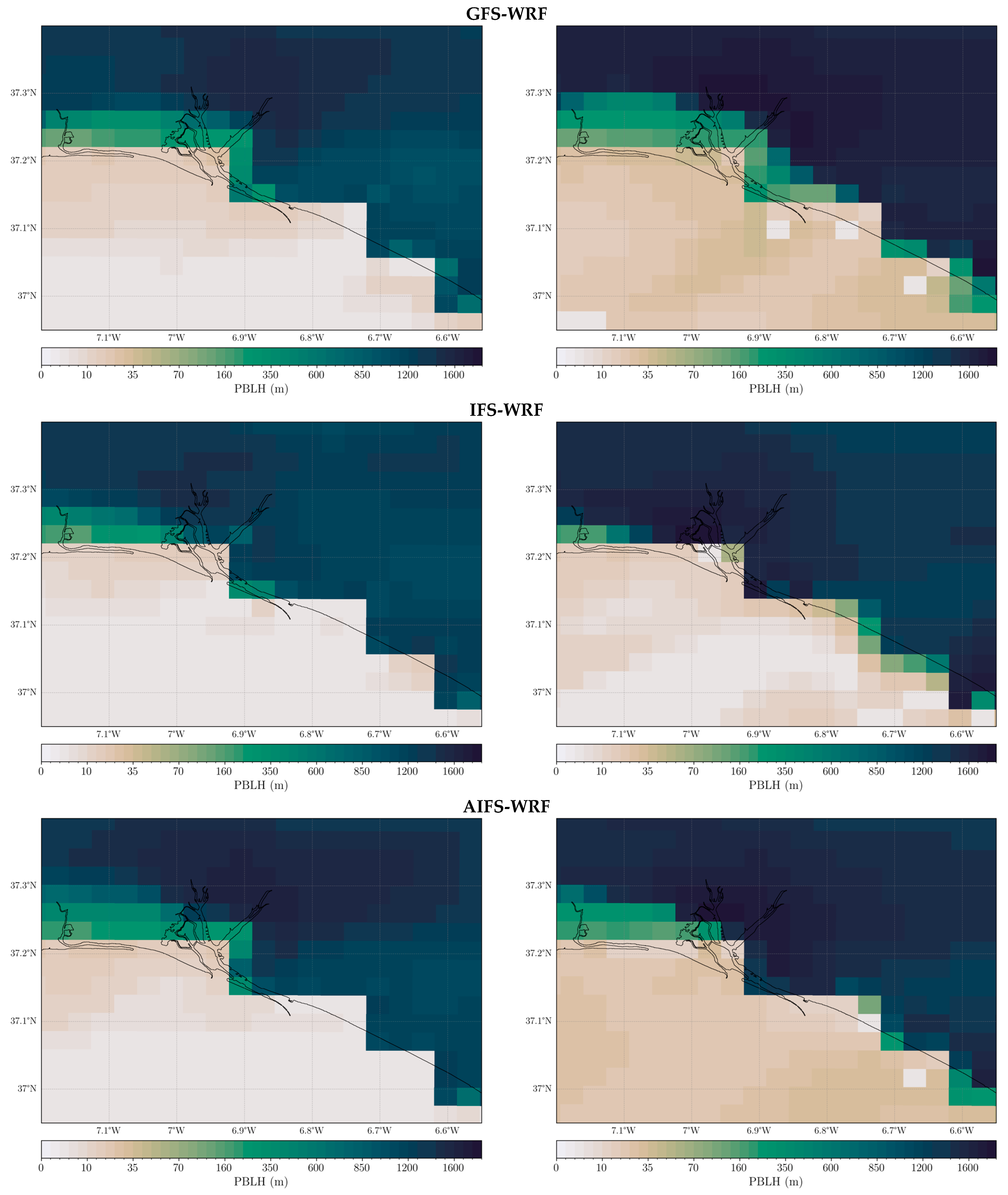
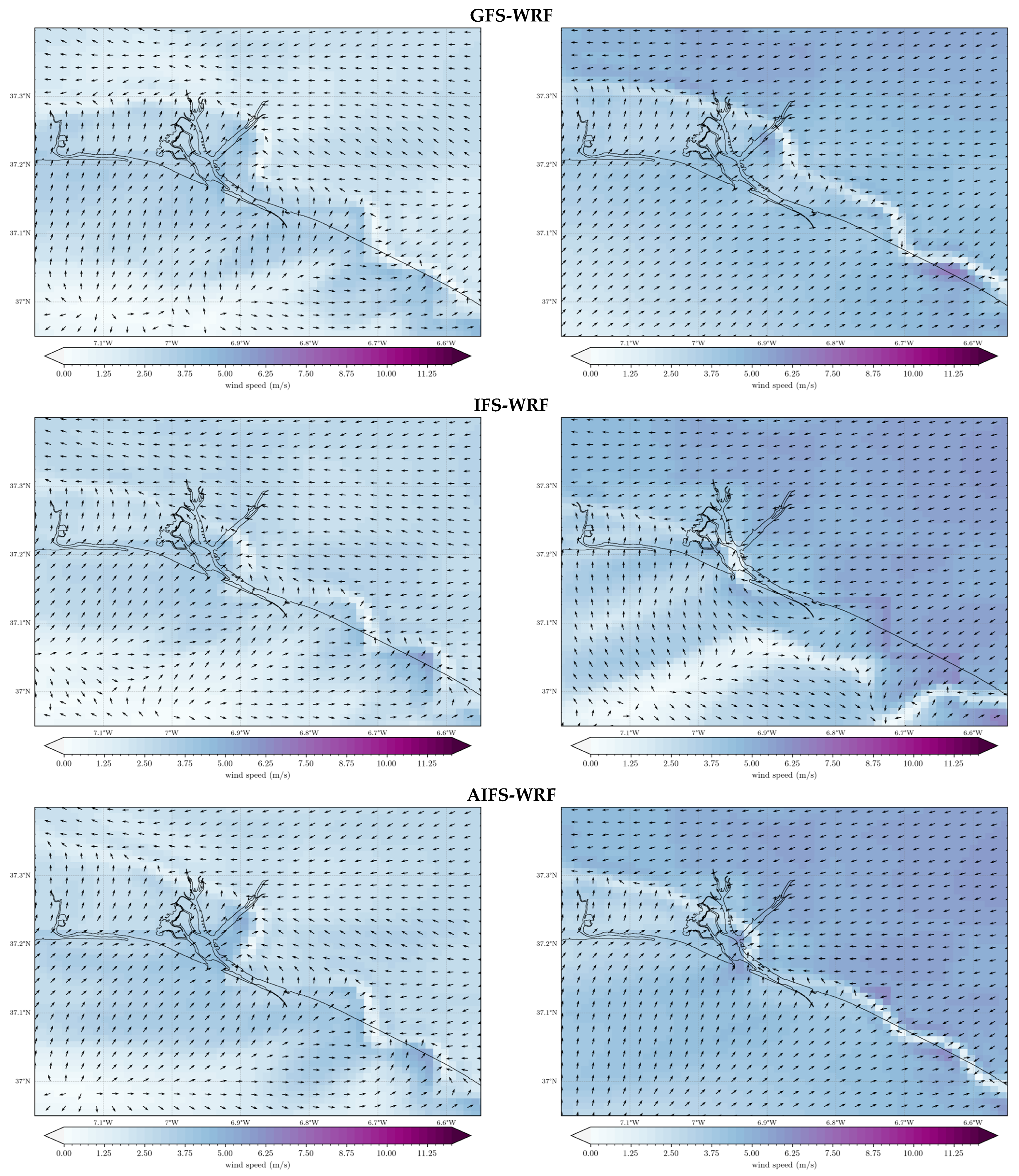

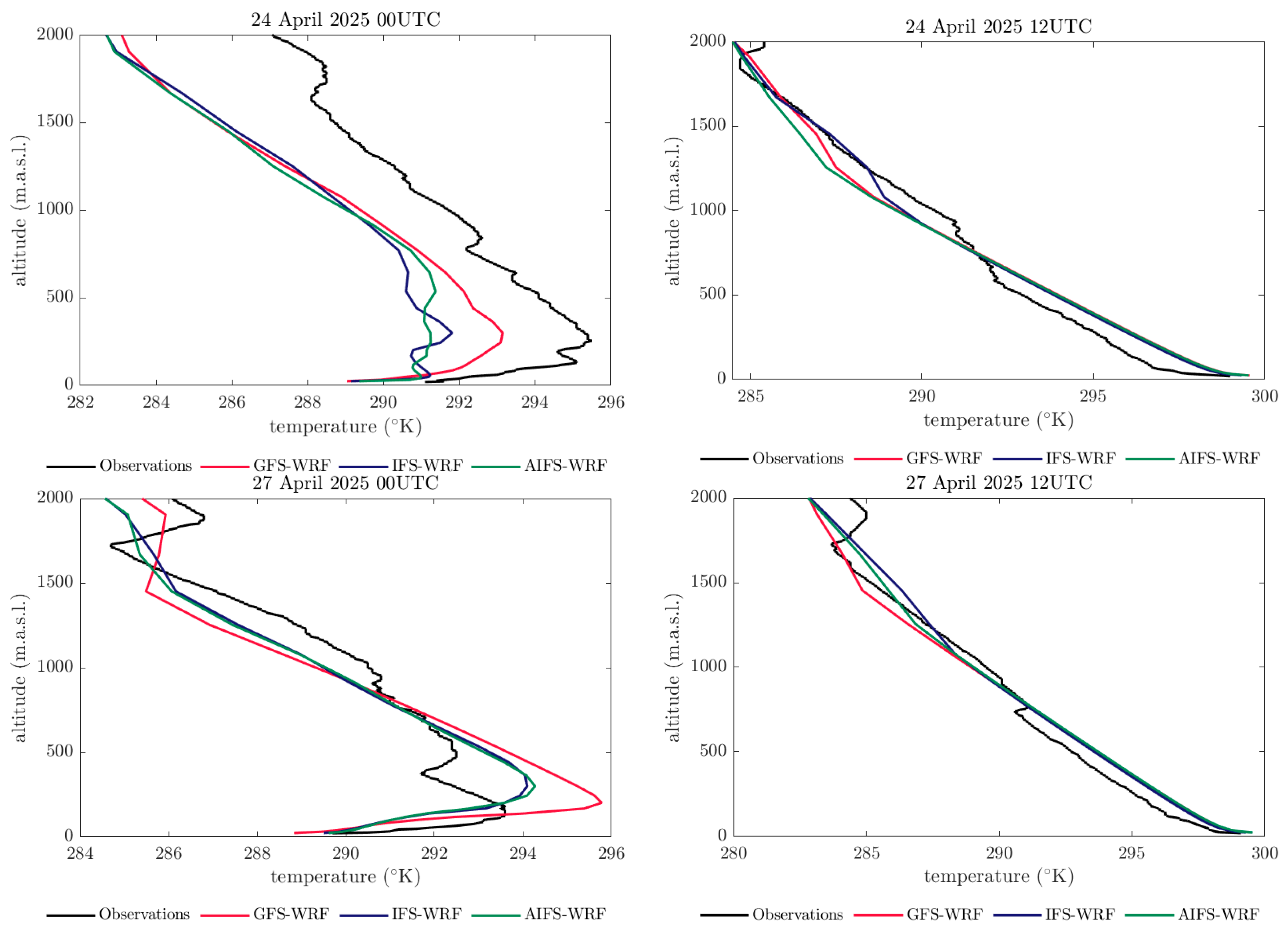
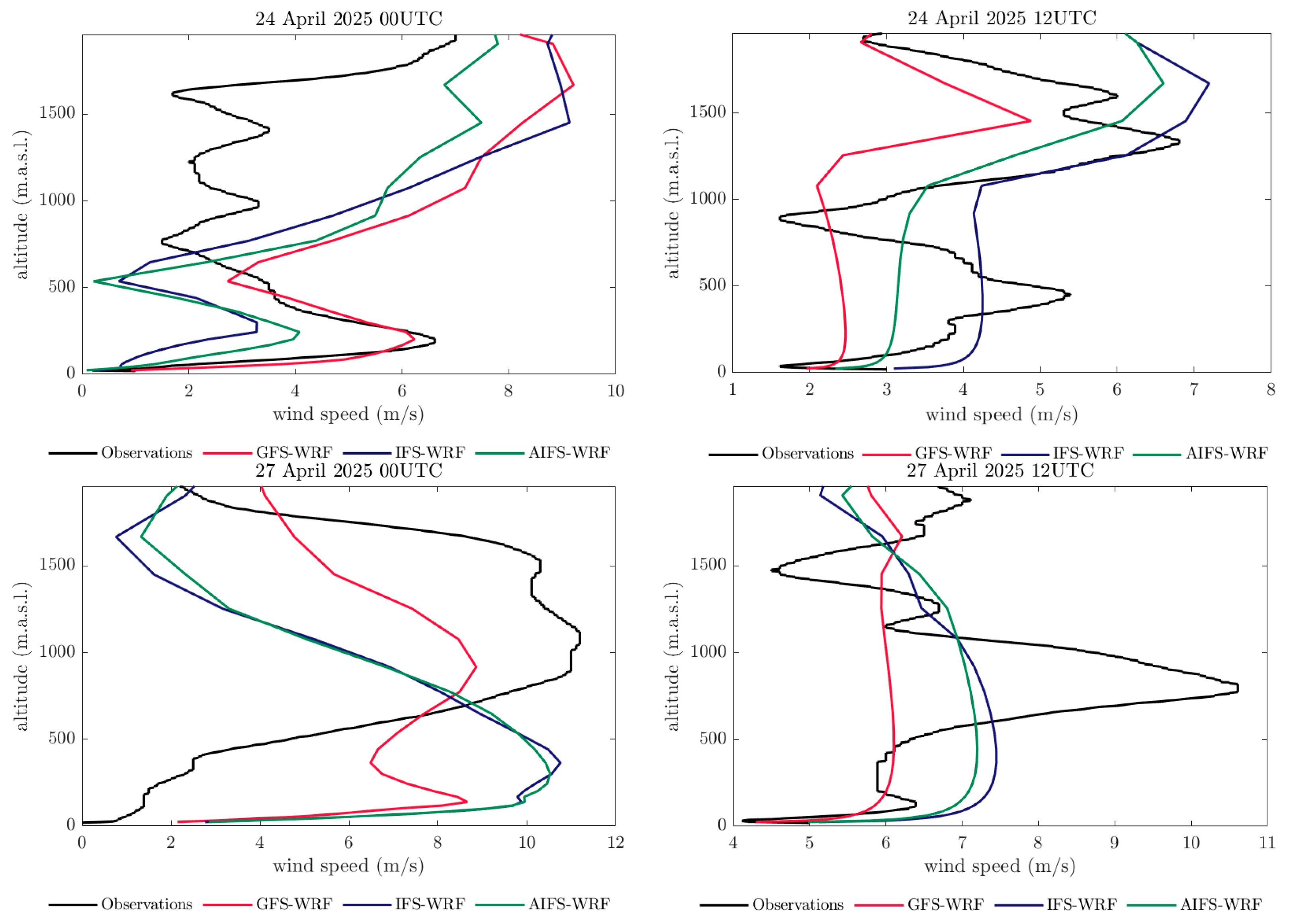
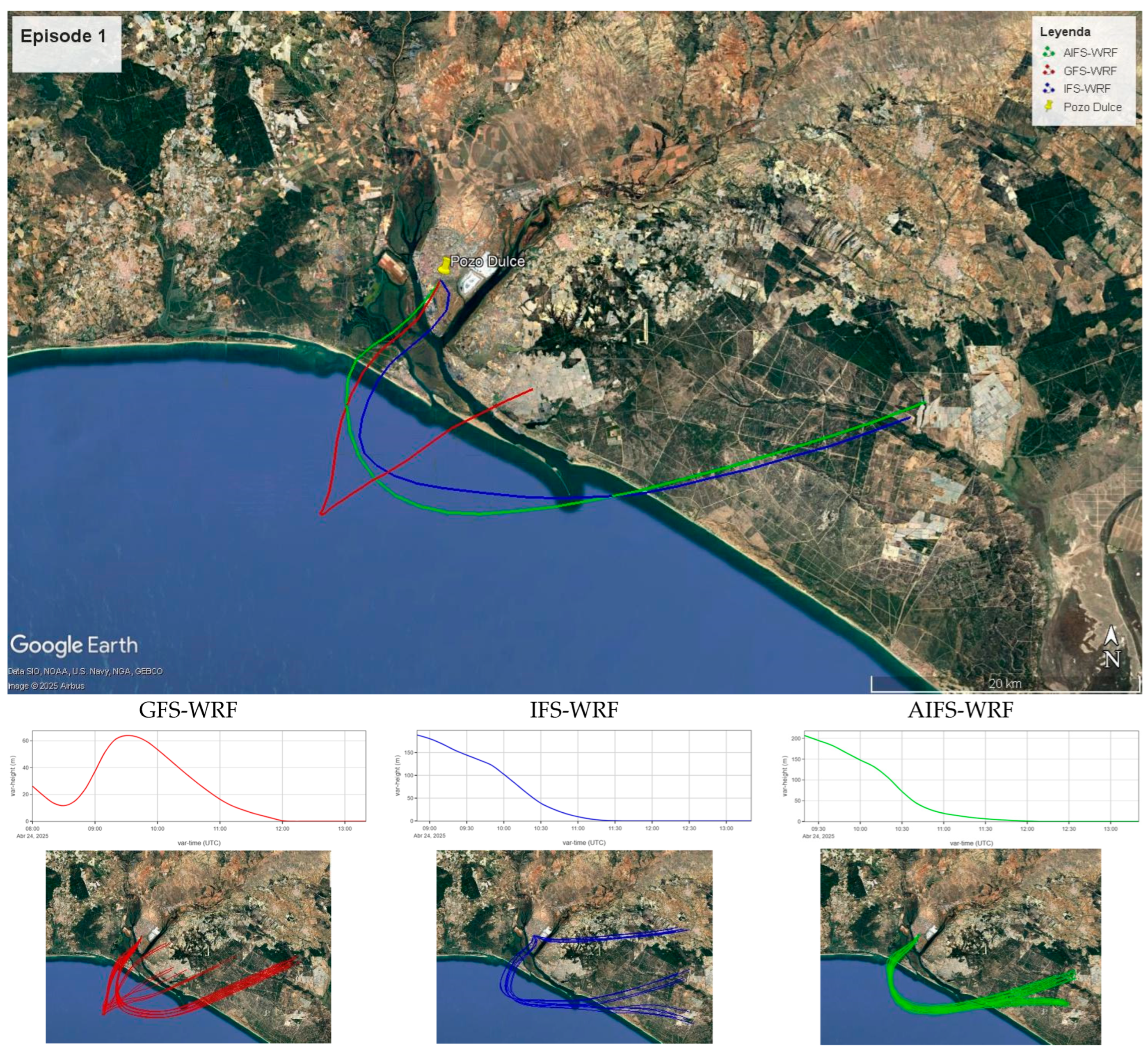






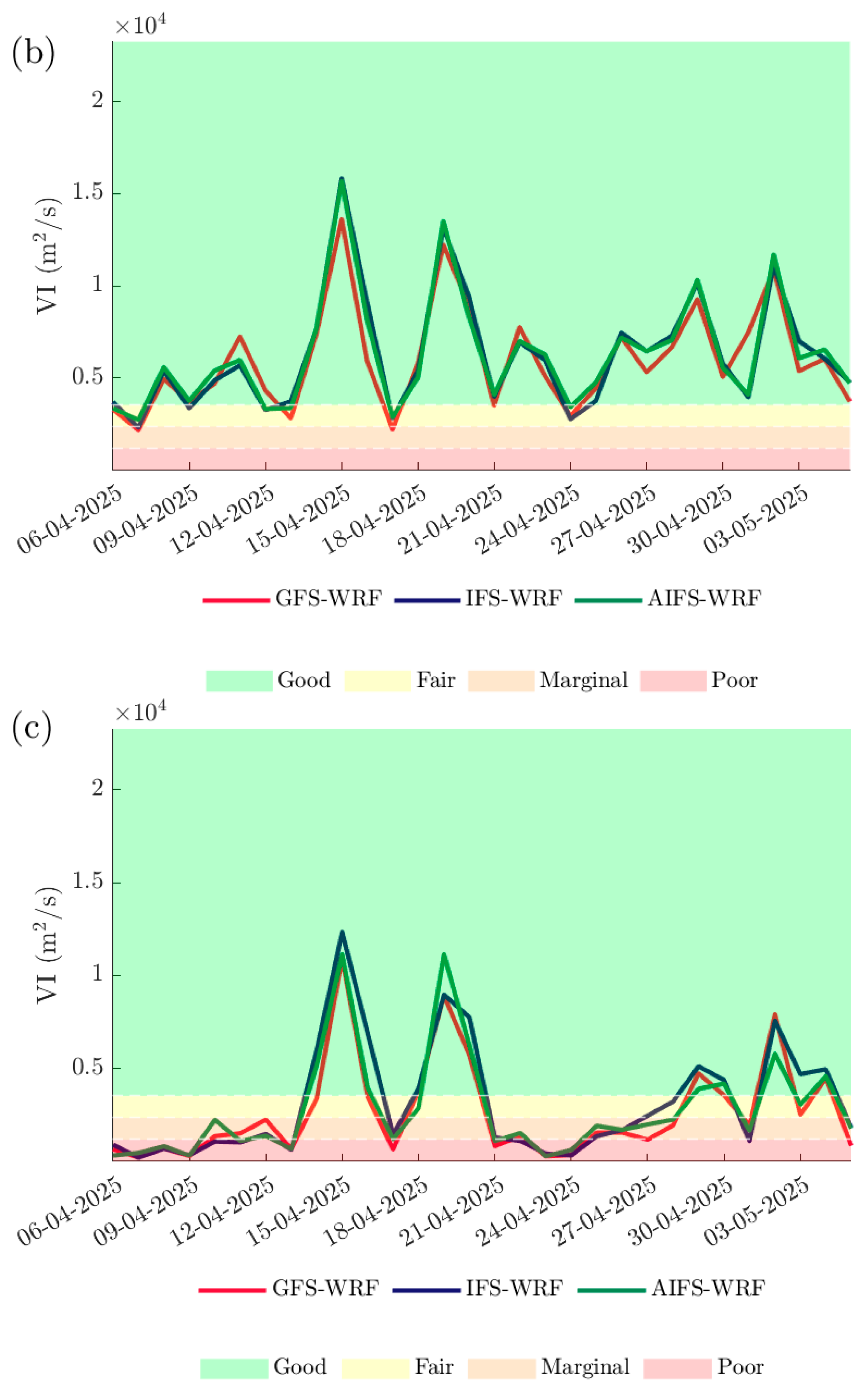
| Meteorological Variable (Reference Height) | Statistic Parameter (Benchmark) |
|---|---|
| Temperature (2 m) | MB (<±0.5 K) MAGE (<2 K) IOA ≥ 0.80 |
| Wind Speed (10 m) | MB (<±0.5 m/s) RMSE (<2 m/s) |
| Wind Direction (10 m) | MB (<±10°) MAGE (<30°) |
| Relative Humidity (2 m) | MB (<±10%) MAGE (<20%) IOA ≥ 0.60 |
| Meteorological Parameter (Reference Height) | Statistic Parameter (Benchmark) | GFS-WRF | IFS-WRF | AIFS-WRF | GFS-WRF | IFS-WRF | AIFS-WRF | GFS-WRF | IFS-WRF | AIFS-WRF | [Units] |
|---|---|---|---|---|---|---|---|---|---|---|---|
| 24 h | 24 h | 24 h | 48 h | 48 h | 48 h | 72 h | 72 h | 72 h | |||
| Temperature (2 m) | MB < ±0.5 K | −1.3 | −0.6 | −0.9 | −1.4 | −0.7 | −0.9 | −1.3 | −0.7 | −0.9 | K |
| MAGE < 2 K | 1.9 | 1.6 | 1.8 | 2.0 | 1.7 | 1.8 | 2.0 | 1.7 | 1.8 | K | |
| IOA ≥ 0.80 | 0.68 | 0.73 | 0.71 | 0.68 | 0.72 | 0.71 | 0.68 | 0.72 | 0.71 | -- | |
| Wind Speed (10 m) | MB < ±0.5 m/s | 1.4 | 1.5 | 1.4 | 1.2 | 1.4 | 1.4 | 1.3 | 1.4 | 1.4 | m/s |
| RMSE < 2 m/s | 2.3 | 2.4 | 2.3 | 2.3 | 2.4 | 2.3 | 2.3 | 2.4 | 2.3 | m/s | |
| Wind Direction (10 m) | MB < ±10° | 21 | 21 | 19 | 23 | 21 | 21 | 23 | 21 | 21 | ° |
| MAGE < 30° | 49 | 49 | 49 | 50 | 50 | 50 | 51 | 51 | 51 | ° | |
| Relative Humidity (2 m) | MB < ±10% | 1.8 | 1.6 | 2.0 | 1.9 | 1.6 | 1.9 | 1.7 | 1.5 | 1.8 | % |
| MAGE < 20% | 8.5 | 7.9 | 8.2 | 8.7 | 8.0 | 8.4 | 8.8 | 8.1 | 8.4 | % | |
| IOA ≥ 0.60 | 0.67 | 0.69 | 0.68 | 0.66 | 0.68 | 0.68 | 0.65 | 0.68 | 0.67 | -- |
Disclaimer/Publisher’s Note: The statements, opinions and data contained in all publications are solely those of the individual author(s) and contributor(s) and not of MDPI and/or the editor(s). MDPI and/or the editor(s) disclaim responsibility for any injury to people or property resulting from any ideas, methods, instructions or products referred to in the content. |
© 2025 by the authors. Licensee MDPI, Basel, Switzerland. This article is an open access article distributed under the terms and conditions of the Creative Commons Attribution (CC BY) license (https://creativecommons.org/licenses/by/4.0/).
Share and Cite
Arasa Agudo, R.; García-Valdecasas Ojeda, M.; Picanyol Sadurní, M.; Codina Sánchez, B. Sensitivity of WRF Operational Forecasting to AIFS Initialisation: A Case Study on the Implications for Air Pollutant Dispersion. Earth 2025, 6, 132. https://doi.org/10.3390/earth6040132
Arasa Agudo R, García-Valdecasas Ojeda M, Picanyol Sadurní M, Codina Sánchez B. Sensitivity of WRF Operational Forecasting to AIFS Initialisation: A Case Study on the Implications for Air Pollutant Dispersion. Earth. 2025; 6(4):132. https://doi.org/10.3390/earth6040132
Chicago/Turabian StyleArasa Agudo, Raúl, Matilde García-Valdecasas Ojeda, Miquel Picanyol Sadurní, and Bernat Codina Sánchez. 2025. "Sensitivity of WRF Operational Forecasting to AIFS Initialisation: A Case Study on the Implications for Air Pollutant Dispersion" Earth 6, no. 4: 132. https://doi.org/10.3390/earth6040132
APA StyleArasa Agudo, R., García-Valdecasas Ojeda, M., Picanyol Sadurní, M., & Codina Sánchez, B. (2025). Sensitivity of WRF Operational Forecasting to AIFS Initialisation: A Case Study on the Implications for Air Pollutant Dispersion. Earth, 6(4), 132. https://doi.org/10.3390/earth6040132






